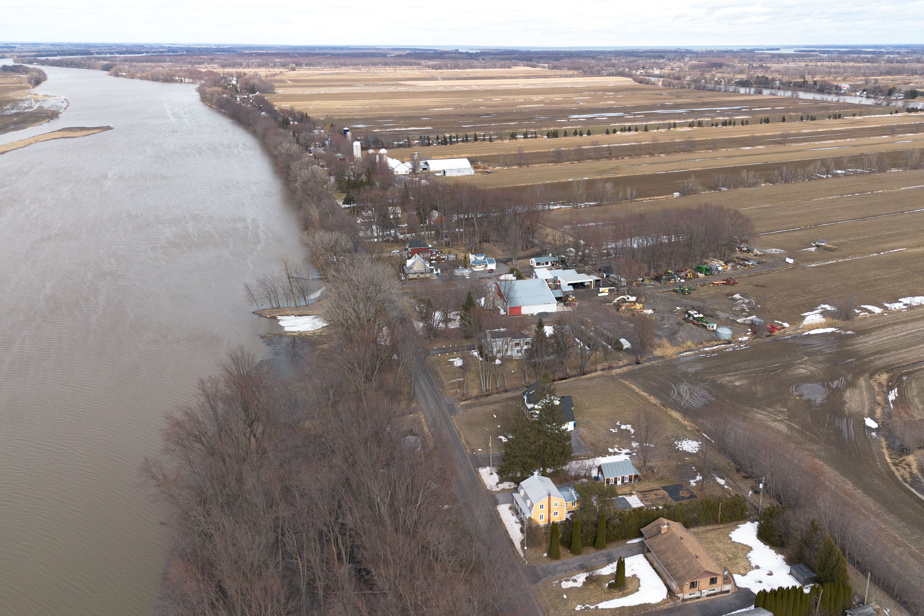“Disaster”, “catastrophe”, the opposition parties are demanding that the Legault government table an adaptation and aid plan for local residents who will face climate change with its new map of flood zones.
“People could lose a lot of money on the value of their home. Their land will no longer be worth anything. Entire villages could become devitalized. It’s catastrophic,” says Liberal MP Virginie Dufour.
Quebec solidaire MP Etienne Grandmont is of the same opinion: “It is not up to the people who have settled legally in these places to pay alone the cost of our collective inaction [face aux changements climatiques]. It’s up to the Quebec government to take note,” he says.
The two elected officials ask the Quebec government to reassure the tens of thousands, or even hundreds of thousands, of people who live in areas that will be labeled as flood-prone with the overhaul of the rules which will be announced soon by the Minister of the Environment Benoit Charette.
The Press reported in the morning the story of Suzanne Leblanc, a woman losing her autonomy, forced to use a dry toilet and wash herself with a washcloth, because she cannot adapt her house due to flood zone rules. Despite the support of its municipality, the Ministry of the Environment, the Fight against Climate Change, Wildlife and Parks (MELCCFP) does not allow any exceptions.
Read our file “Prisoners of flood zones”
Multiply the surface area of flood zones by four
Regulatory restrictions, loss of value, difficulty selling your home and obtaining insurance. Many homeowners could find themselves stuck with their homes because of new flood zone maps in the works, according to city officials and experts.
The new regulation in preparation at the Ministry of the Environment will add a third zone, that of “100-350 years”, according to a document obtained by The Press. There will also be a “generalized increase in flood levels” to take into account the frequency of floods in recent years and the impacts of climate change, in particular the risks of failure of water retention efforts by Hydro-Québec in the North. .
“It’s going to be huge,” says liberal Virginie Dufour, who knows the issue well. This former municipal representative in Laval worked on this issue in 2020, when the Quebec state took action after the floods of 2017 and 2019.

PHOTO EDOUARD PLANTE-FRÉCHETTE, LA PRESSE ARCHIVES
Virginie Dufour
With the 0-350 year, she estimates that we will “expand by three to four times the areas covered by the 0-100 year”. She fears that insurers and mortgage lenders will use this information to leave these markets, as Desjardins did in the 0-20 years. “It’s scary. All these properties will be at risk of no longer being mortgaged. It’s worrying. Are these people going to lose their homes? I don’t hear the government on this issue. Is he ready to take over? ”, she lets fall.
REM in a flood zone?
She even believes that “entire neighborhoods are being built at the moment” in areas that will be deemed at risk. “The REM de l’Ouest in Laval passes through areas like that. We are perhaps opening a Pandora’s box. But I don’t see where we are pushing towards resilience,” she says. She believes that the State should promote the construction of dikes and walls to “physically protect” neighborhoods.
As for the regulatory straitjacket which prevented Mme Leblanc to arrange a bathroom for herself, “she is far from being the only one in her situation,” says Mme From the oven. “Citizens have already contacted me about this. People found themselves trapped, not being able to do what they thought they could do with their land,” she says.
Someone who would like to build a house on stilts or a resilient house cannot do so. Some sectors are completely paralyzed, even though there are solutions. We are not the only place in the world to experience flooding.
Virginie Dufour
“Where is our adaptation? I do not see her. The government has been working on this for five years. It’s too long,” she says.
Mme Dufour also doubts the maps of the Ministry of the Environment. Flood forecasting is a “complex science”. To challenge the ministry’s ratings, the city of Laval had to pay for a study costing $1.5 million “for a single river”.
She fears that the maps are made with a “very rough line”. “It’s important to know our territory, but I’m far from convinced that the ratings that will come out of this exercise will reflect reality,” she says.
Financial aid
For his part, solidarity worker Etienne Grandmont is asking that the Quebec state count the residences that will be in flood zones with its new mapping exercise. For the moment, the ministries of Public Safety and the Environment are ignoring it.
“The situation has changed [avec les changements climatiques]. It’s not the people who are at fault. We are asking to set up an inventory of residences affected by the new mapping, to measure the extent of the phenomenon, and establish the funds that must be made available,” he says.
He believes that the Quebec state must be there to financially help affected owners. Otherwise he fears that they will find themselves “prisoners” of their home. “They will never be able to resell it. […] The government must be there to reassure everyone,” he said.
In a written statement, Parti Québécois MP Joël Arseneau also asks for help for citizens. “It is clear that the submission of a new framework, a new mapping of flood zones will require adaptation and support measures for the communities and home owners affected. We cannot put this consequence of climate change on their shoulders alone,” he explained.
He also points out that his party proposed during the last election campaign “a Just Transition Fund to help citizens deal with the impacts of climate change so that they are not the only ones to bear this burden”.
